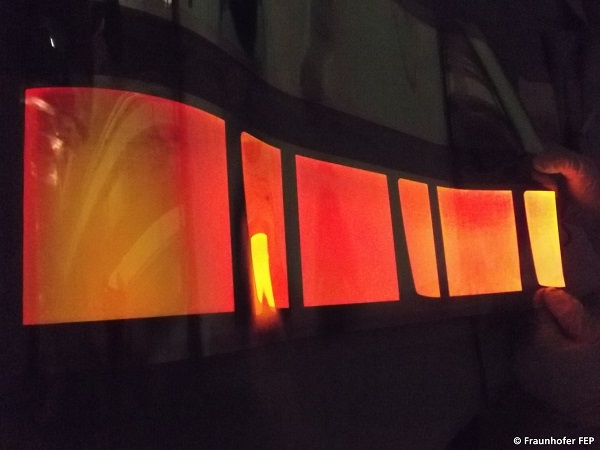Cytocompatibility studies of organic light-emitting diodes (OLEDs) have been carried out on cell cultures for the first time at the Fraunhofer FEP to test how well OLEDs are tolerated by cells. The results offer promising prospects for the use of OLEDs in the medical field, such as in light therapy. The findings will be published in a white paper entitled “Preliminary cytocompatibility studies for encapsulated OLEDs” and likewise be presented at the 4th Industry Partners Day of the Fraunhofer FEP in Dresden on Sept. 28, 2016.
Light therapy is an important means of promoting the healing of wounds. Difficult and protracted healing processes of the skin, such as are due to chronic and infected wounds, present a challenge for treating physicians and can be positively affected by exposure to light.
The Fraunhofer FEP in Dresden has years of experience researching processes, technologies, and applications for flexible OLEDs. In order to be able to employ these area light sources for potential medical applications though, any potential toxic effects caused by the constituent materials must be precluded. No such studies on what is termed the cytocompatibility of flexible OLEDs were known of to date.
 |
|
The Fraunhofer FEP in Dresden is conducting Cytocompatibility studies of organic light-emitting diodes (OLEDs). (All photos courtesy of The Fraunhofer FEP) |
Now for the first time, the cytocompatibility of flexible OLED systems has been evaluated in a pilot study. Dr. Schönfelder, head of the Medical Applications Research Group at Fraunhofer FEP, recounts enthusiastically: “Even after electrical operation and exposure to mechanical loading by bending, no toxic substances able to alter cells diffused from the OLEDs.”
As a follow-on, studies on the influence of OLED light were conducted using in vitro cell cultures from the skin and the immune system suffering from specified damage. Initial results indicate effects of accelerated auto-recovery that could be the foundation for future therapeutic applications.
Division Director Dr. Christian May in looking ahead remarks: “We need long-term studies yet to be able to guaranty cytocompatibility during exposure to OLED light. Safe electrical connections, power supplies, control circuitry, and component perimeter seals are important aspects that we are dedicating ourselves to – before direct application to the patient is allowed.”
Detailed findings can be reviewed in the white paper entitled „Preliminary cytocompatibility studies for encapsulated OLEDs“ and will also be presented by Dr. Jacqueline Hauptmann in her talk entitled “OLED light application in medicine and cytotoxicity of the materials” during the 4th Industry Partners Day devoted to medical topics at the Fraunhofer FEP on September 28, 2016.
Registration and program materials can be found at www.fep.fraunhofer.de/ipd. Sponsorship opportunities at the event as well as participation via info kiosks are available.
 |
|
The Fraunhofer FEP in Dresden testing cytocompatibility studies of RGB OLEDs. |





 CN
TW
EN
CN
TW
EN







